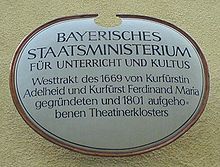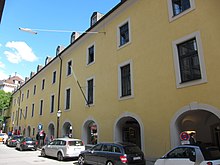Bavarian State Ministry for Education and Culture
|
Bavarian State Ministry for Education and Culture |
|
|---|---|
| State level | Free State of Bavaria |
| position | Supreme state authority |
| Headquarters | Munich |
| Authority management | Minister of State Michael Piazolo |
| Budget volume | EUR 13.655 billion (2020) |
| Web presence | www.km.bayern.de |
The Bavarian State Ministry for Education and Culture (StMUK), colloquially the Bavarian Ministry of Culture (KM), is a ministry of the Free State of Bavaria with its headquarters at Salvatorstrasse 2 and other office buildings at Jungfernturmstrasse 1 and on Praterinsel 2 in Munich . Before handing over competencies to the newly founded Bavarian State Ministry for Science and Art in March 2018 , the Ministry was named Bavarian State Ministry for Education and Culture, Science and Art .
Michael Piazolo ( Free Voters ) has been Minister of State since November 12, 2018 , State Secretary is Anna Stolz (Free Voters). Head of office is Ministerial Director Herbert Püls.
history
Office building in Salvatorstrasse
After Maximilian IV Joseph, who later became King Maximilian I Joseph of Bavaria, ordered the relocation of the Department of Foreign Affairs to the Theatine Monastery in Munich in 1799 , he ordered the evacuation of the spacious monastery on October 26, 1801, even before general secularization ( see History of the Theatine Church ) and after 1801 also settled the three other ministries for finance , justice and spiritual matters there. A number of other authorities were added in the first half of the century. After it was founded in 1846, the Ministry of Culture was also assigned its offices in the Secret Ministerial Building, as the Theatin building was often called in official language. The departure of the Ministry of Finance (1865) and the dissolution of the Ministry of Commerce (1871) brought relief with regard to the spatial problem that had arisen. The Ministry of Culture was able to occupy the west wing of the former monastery and only had to share the building with the Ministry of the Interior from 1880 to 1945. After the reconstruction after the Second World War , which was completed in 1973 , the Ministry of Culture had control of the entire building complex except for the shops on the street fronts and in the Theatinerhof. From 1986 to 1989 and from 1998 to 2013, when it was divided into an independent culture and science department, both ministries were housed in the building.
Political development
The forerunners of the Ministry of Culture include the Spiritual Council for the supervision of church and school affairs in the former Duchy of Bavaria and the Department of Spiritual Affairs, which emerged in 1764 from the Secret Council Conference (later: Secret State and Conference Ministry ) of 1726 . The latter was abolished in 1806 and the responsibility for church and school affairs was assigned to the Department of the Interior . King Ludwig I of Bavaria , who highly valued his interior minister Karl von Abel as a statesman, but did not approve of his ecclesiastical stance, released the area of responsibility of ecclesiastical affairs with the ordinance of December 15, 1846 from the area of responsibility of the Department of the Interior and handed it over on January 1, 1847, to the separately established department called the Ministry of the Interior for Church Affairs . With the renaming to "State Ministry of the Interior for Church and School Affairs", Ludwig I expanded his area of responsibility from February 27, 1847 to "all subjects of education, teaching, moral, intellectual and artistic education and the institutions existing for this". King Maximilian II of Bavaria , who had made the promotion of science his main task, had a great personal influence on the cultural and political work of the ministry . He reformed the elementary school system and high school education. His ministers Friedrich von Ringelmann and then Theodor von Zwehl directed the preparatory work on the school regulations for the higher education institutions from 1854.
During the reign of King Ludwig II of Bavaria , ecclesiastical and cultural-political disputes shaped the work of the ministry, the climax of which under Johann von Lutz was the denial of permission to proclaim the resolutions of the First Vatican Council of 1869/70, the enforcement of the pulpit paragraph in German Reichstag in 1871 and the School District Ordinance of August 29, 1873, which encouraged the formation of mixed denominational schools. Only with the revision of August 26, 1883 in favor of the denominational school and the instructions of Prince Regent Luitpold, who had ruled since 1886, to resolve the ecclesiastical conflicts, the political climate improved again.
After the dissolution of the Ministry of Commerce in 1871, the Ministry of Culture also administered technical and agricultural education. Under Ludwig August von Müller , the school regulations of July 23, 1891 revised the curricula for the higher education institutions. Robert von Landmann ensured an improvement in the commercial technical school system and with the School Supplies Act of July 28, 1902 for the material improvement of the teaching profession . Under Anton von Wehner , the state school commission was established in 1905 as the highest level for primary school issues and in 1909 the ministerial department for higher education.
On June 14, 1907, the upper secondary school, which was equivalent to the grammar school, was launched and on April 8, 1911 the school regulations for the higher girls' schools in Bavaria were issued. By ordinance of November 20, 1910, the lyceums were transformed into philosophical-theological colleges. Von Wehner also had the parish order to reorganize the administration of church assets drawn up. Under Eugen Ritter von Knilling , the new school regulations for the higher education institutions were issued on May 30, 1914 . After the First World War , the Bavarian school system was reorganized during the terms of Franz Matt and Franz Goldenberger and the relationship between state and church was reorganized.
As part of the DC circuit of the countries 1933/1934 the Ministry of Culture was built during the era of National Socialism an Empire Safety Authority.
After the devastation of World War II, the main task of the Bavarian Ministry of Culture for many years was to reorganize the field of cultural maintenance. Under Hans Maier , the elementary schools were reorganized, 200 new secondary schools and the universities of Regensburg and Augsburg were established. After the organizational separation into a State Ministry for Education and Culture and a State Ministry for Science and Art (Minister: Wolfgang Wild ) between 1986 and 1990, the State Ministry for Education, Culture, Science and Art was divided again in October 1998. Hans Zehetmair became Minister for Science, Research and Art , Monika Hohlmeier Minister for Education and Culture, followed by Siegfried Schneider in 2005 and Ludwig Spaenle in 2008 . In 2013, both departments were merged again to form the Bavarian State Ministry for Education and Culture, Science and Art. In March 2018 (at that time the Söder I cabinet was formed ) there was another division: some of the tasks were handed over to the newly founded Bavarian State Ministry for Science and Art ; the Ministry of Culture was named the Bavarian State Ministry for Education and Culture .
Rejection of a text critical of religion from an English textbook in 2010
The ministry received greater media attention in 2010 when it asked Cornelsen Verlag to remove a text critical of religion by the American journalist Susan Jacoby from the English textbook Context 21 , which dealt with religious fundamentalism in the USA. It is believed that the Evangelical News Agency Idea helped remove the text.
See also
literature
- Maria Magdalena Bäuml: cultural policy against the crisis of democracy . The Bavarian State Ministry for Education and Culture 1926-1933 (= series of publications on Bavarian national history . Volume 168 ). CH Beck, Munich 2018, ISBN 978-3-406-10783-2 ( limited preview in Google book search).
- Winfried Müller : Gauleiter as Minister. The Gauleiter Hans Schemm, Adolf Wagner, Paul Giesler and the Bavarian State Ministry for Education and Culture 1933 - 1945 , in ZBLG 60 (1997), pp. 973-1022 ( online )
Web links
- Official website
- Literature from and about the Bavarian State Ministry for Education and Culture in the catalog of the German National Library
Individual evidence
- ↑ stmfh.bayern.de: https://www.stmfh.bayern.de/haushalt/staatshaushalt_2019/haushaltsplan/. Retrieved June 26, 2020 .
- ↑ KM: Organigram of the Bavarian State Ministry for Education and Culture, Science and Art (PDF)
- ↑ SPIEGEL ONLINE, accessed on September 26, 2011
- ↑ boersenblatt.net of June 28, 2011, accessed on September 26, 2011
Coordinates: 48 ° 8 ′ 28.6 ″ N , 11 ° 34 ′ 34.9 ″ E





